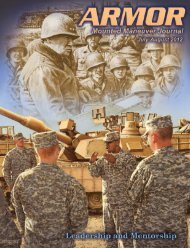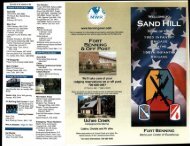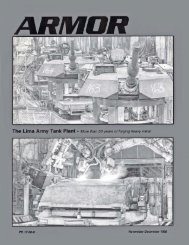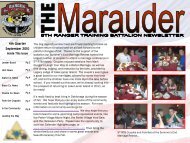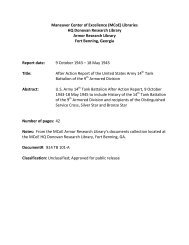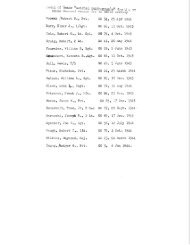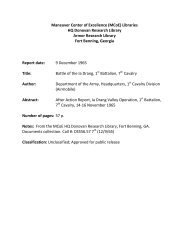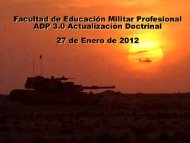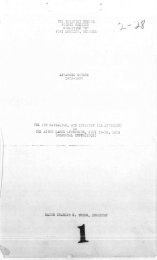ARMOR, September-October 1987 Edition - Fort Benning - U.S. Army
ARMOR, September-October 1987 Edition - Fort Benning - U.S. Army
ARMOR, September-October 1987 Edition - Fort Benning - U.S. Army
You also want an ePaper? Increase the reach of your titles
YUMPU automatically turns print PDFs into web optimized ePapers that Google loves.
Graduate Studies<br />
in Combat Vehicle<br />
Technology<br />
by Richard M. Ogorklewlcz<br />
The design and development of<br />
combat vehicles is a demanding<br />
process which calls for a high de-<br />
gree of specialized knowledge and<br />
skill on the part of those involved in<br />
it. Some of that knowledge and skill<br />
can be acquired by operating com-<br />
bat vehicles. More of it can be ac-<br />
quired by actually working on the<br />
design and development of combat<br />
vehicles. But to’ operate or work on<br />
combat vehicles generally involves<br />
concentration on particular tasks or<br />
problems, which leaves little time<br />
for the acquisition of knowledge<br />
and experience outside the areas of<br />
immediate concern. In conse-<br />
quence, this way of acquiring wider<br />
knowledge tends to be very<br />
protracted, even though it is the<br />
best in several respects.<br />
There is, therefore, a need for ad-<br />
ditional opportunities for acquiring<br />
the relevant knowledge. In par-<br />
ticular, there is a need for acquiring<br />
a sound, broad-based understanding<br />
of combat vehicle technology and<br />
for doing it more rapidly than is pos-<br />
sible by working on a job, or at an<br />
earlier state of the career of those<br />
involved in the design and develop-<br />
ment of combat vehicles.<br />
All this has been recognized by<br />
the creation at the Royal Military<br />
College of Science in England of a<br />
graduate course in Military Vehicle<br />
Technology. Apart from meeting an<br />
important need, the MVT course is<br />
believed to be the only one of its<br />
Headquarters of the Royal Military College of Science, Shrivenham.<br />
kind in the whole Western World,<br />
which in itself makes it of con-<br />
siderable interest. The writer is also<br />
able to comment on it from first-<br />
hand experience, having been in-<br />
vited to act as an external academic<br />
examiner to it.<br />
The Royal Military College<br />
What the MVT course offers is<br />
based on a sound academic founda-<br />
tion provided by the well-estab-<br />
lished record of the Royal Military<br />
College of Science. In fact, RMCS<br />
can trace its ancestry to 1772, when<br />
at England’s oldest arsenal at Wool-<br />
wich a society was formed for the<br />
scientific study of gunnery. From<br />
this grew a university-type military<br />
institution, which since WW I1 has<br />
been located on a spacious campus<br />
at Shrivenham, some ‘80 miles west<br />
of London.<br />
The basic function of RMCS is to<br />
provide scientific and technological<br />
education to military personnel in<br />
the form of a three-year bachelor of<br />
science program and a large num-<br />
ber of specialist courses ranging in<br />
duration from a few days to six<br />
months. The RMCS also col-<br />
laborates with the British <strong>Army</strong><br />
Staff College at Camberley in run-<br />
ning the scientific and technological<br />
parts of the <strong>Army</strong> Staff Course. In<br />
addition to the MVT course, it runs<br />
other graduate courses in military<br />
systems and technology and it also<br />
carries out research for the British<br />
Ministry of Defense and for in-<br />
dustrial organizations.<br />
All this implies that the MVT<br />
course is run against a wide back-<br />
ground of academic and military ac-<br />
tivities, which ensures that it is com-<br />
prehensive and relevant to current<br />
military problems. The MVT course<br />
also enjoys the advantage of the<br />
facilities provided by the RMCS,<br />
which include not only conventional<br />
engineering laboratories but also<br />
such things as an instructional col-<br />
lection of modern British and other<br />
armored vehicles and a unique<br />
teaching exhibit in the form of a<br />
wide range of standard and ex-<br />
perimental tank guns.<br />
Military Vehicle<br />
Technology Course<br />
The MVT course itself consists of<br />
a short introductory period, a core<br />
<strong>September</strong>-<strong>October</strong> <strong>1987</strong> <strong>ARMOR</strong> 21



